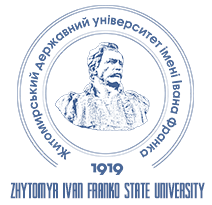THE USE OF GOOGLE EARTH PLATFORM BY THE ENGLISH LANGUAGE TEACHER DURING TEACHING GRAMMAR
DOI:
https://doi.org/10.35433/pedagogy.1(108).2022.232-239Keywords:
Google Earth, platform, English teacher, student, virtual trip, virtual route, English grammar, morphology, syntaxAbstract
The article describes the possibilities of using Google Earth in teaching English grammar to education seekers. To achieve this goal, the following methods were used: theoretical – analysis, synthesis of personal and domestic scientists’ pedagogical experience regarding the Google Earth usage in teaching English; statistical – analysis of students’ survey results. The author highlightes the main online platforms of the Google Company for teaching English to students, among which Google Earth, a free platform for the satellite displaying planets Earth, Mars and the Moon virtually, is considered to be promising for it. A survey has been conducted (104 students of the Faculty of Ukrainian and Foreign Philology of Hryhorii Skovoroda University in Pereiaslav, Ukraine, aged 17 to 19, both sexes), containing 5 main questions ("Do you know the Google Earth platform?", "Do you know how to use Google Earth?", "Have you already used Google Earth?", "Do you know how to use Google Earth to teach English vocabulary to school students?", "Do you know how to use Google Earth to teach English grammar to school students?", "Are you interested in learning about the possibilities of using Google Earth to teach English to students?"). The results of the survey show that the Google Earth platform is well-known only to19% of future English teachers, but is interesting to all of them in terms of future usage in teaching English, including grammar; only 7% of respondents know how to use it in teaching English vocabulary and 4% know how to use it in teaching English grammar to school students. The article describes the advantages of the Google Earth platform over Google Maps, names the possibilities of using this platform by an English teacher to teach English grammar, which could allow students to improve skills in morphology and syntax, develop creativity and intercultural competence, providing intercultural dialogue. The prospect of further research is a detailed study of the platform advantages and disadvantages for the formation of the future English teacher’s foreign language competence.
References
Begeka, D.A. (2019). Linguo-social and cultural competence as a factor of professional training of future foreign philology teacher. Astra Salvensis-revista de istorie si cultura, 7(13), 441-455 [in English].
Biruk, N.P. (2021). Profesiyno-tvorchyy rozvytok osobystosti pedahoha-doslidnyka v umovakh diyalʹnosti naukovo-pedahohichnoyi shkoly [Professional and creative development of the personality of the teacher-researcher in the conditions of activity of the scientific and pedagogical school]. Candidate’s thesis. Zhytomyr: Zhytomyr. derzh. un-t im. Ivana Franka. Retrieved from: http://eprints.zu.edu.ua/32583/1/dys-Biruk.pdf [in Ukrainian].
Chayuk, T., & Zhyhadlo, O. (2021). Znachennya elektronnykh osvitnikh resursiv dlya vykladannya anhliysʹkoyi movy u zakladakh vyshchoyi osvity [The importance of electronic educational resources for teaching English in higher education institutions]. InterConf, (90), 132-138. DOI: 10.51582/interconf.7-8.12.2021.016 [in Ukrainian].
Martyushev, N., Shutaleva, A., Malushko, E., Nikonova, Z., & Savchenko, I. (2021). Online Communication Tools in Teaching Foreign Languages for Education Sustainability. Sustainability, 13, 11127. DOI: 10.3390/su131911127 [in English].
Nugroho, A., Ilmiani, D., & Rekha, A. (2021). EFL Teachers’ Challenges and Insights of Online Teaching amidst Global Pandemic. Metathesis: Journal of English Language, Literature, and Teaching, 4(3). DOI: 10.31002/metathesis.v4i3.3195 [in English].
Oliynyk, O.V. (2014). Innovatsiyni tekhnolohiyi dystantsiynoho navchannya inozemnoyi movy dlyastudentiv nemovnykh VNZ [Innovative technologies of distance learning of a foreign language for students of non-language universities]. Linhvistychni doslidzhennya – Linguistic research: zb. nauk. pratsʹ KHNPU imeni H.S. Skovorody, vyp. 38, 238-246 [in Ukrainian].
Onyshchenko, N., Serdiuk, N., & Krykun, V. (2021). Pre-service teachers’ training for the innovative extracurricular work. Advanced Education, 8(19), 20-32. DOI: 10.20535/2410-8286.225789 [in English].
Postolenko, I.S. (2014). Navchannya inozemnykh mov dystantsiyno: intehratsiynyy aspekt [Teaching foreign languages remotely: integration aspect]. Problemy pidhotovky suchasnoho vchytelya – Problems of modern teacher training, № 9(2), 54-60. Retrieved from: http://nbuv.gov.ua/UJRN/ppsv_2014_9(2)__9 [in Ukrainian].
Romanyuk, S.M. (2016). Dystantsiyne navchannya inozemnoyi movy: porivnyalʹnyy analiz suchasnykh platform ta onlayn-servisiv [Distance learning of a foreign language: a comparative analysis of modern platforms and online services]. Visnyk Dnipropetrovs’koho universytetu imeni Al’freda Nobelya. Seriya: Pedahohika i psykholohiya – Bulletin of the Alfred Nobel University of Dnepropetrovsk. Series: Pedagogy and Psychology, (1), 318-325 [in Ukrainian].
Serdiuk, N. (2017). Modern trends in methods of foreign language training at the institutions of higher education in Ukraine. Theoretical and Didactic Philology, (26), 101-109. Retrieved from: https://tdp-journal.com/index.php/journal/article/view/57 [in English].
Downloads
Published
Issue
Section
License

This work is licensed under a Creative Commons Attribution-NonCommercial-NoDerivatives 4.0 International License.
Authors published in this journal agree to the following terms:
a) The authors reserve the right to author their work and grant the journal the right to first publish this work under the Creative Commons Attribution License, which allows others to freely distribute the published work with a mandatory link to the authors of the original work and the first publication of the work therein magazine.
b) Authors have the right to enter into separate additional agreements regarding the non-exclusive distribution of the work in the form in which it was published by this journal (for example, posting work in an electronic repository of the institution or publishing as part of a monograph), provided that the reference to the first publication of the work is maintained therein. magazine.
c) Journal policy permits and encourages the submission of manuscripts by the authors on the Internet (for example, in repositories of institutions or on personal websites), both prior to submitting this manuscript to the editorial board and as it contributes to the emergence of productive scientific discussion, and has a positive impact on the promptness and dynamics of citing a published work (see The Effect of Open Access).

 ISSN
ISSN 





